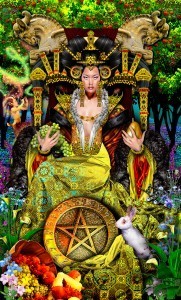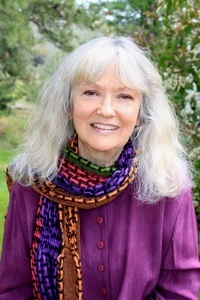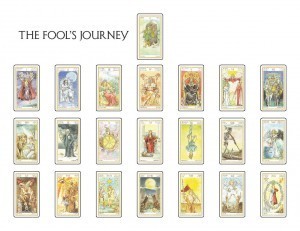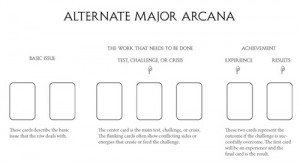Llewellyn Publications's Blog, page 85
July 2, 2013
A Study of the Fool’s Journey 1
This month the Llewellyn Tarot blog will feature a series of articles exploring the Fool’s Journey using Rachel Pollack’s Alternate Major Arcana Spread, found HERE.
The Fool’s Journey was coined by Eden Gray. The Fool card is said to journey through the Majors in order, gaining spiritual wisdom and learning lessons along the way. As the idea resonated with readers, people began laying out the Majors in certain configurations, like a spread, which influenced the interpretation of the journey.
For this month’s study, we will use this configuration based on the spread Rachel developed:
We will place the Fool at the top and the rest of the Majors in order in three rows of seven cards each. Using the Lo Scarabeo Tarot, it looks like this:
Here is a picture of what a single row looks like:
In the next entry we will look at the first two cards, The Magician and The High Priestess
June 28, 2013
Let’s Do Some Magick!
It seems like many times when I personally meet some people, get friendly, and spend some time with them, at least one of them gets into this conversation with me:
Let’s do some magick!
“Great,” I say! “I’d love to do magick with you. What shall we do the magick for?”
Uhh…
And a few times this brief conversation has resulted in that person not wanting to talk with me any more.
— — —
Once, while I participating on a very active online forum, a young man—a self-professed practitioner of Chaos Magick—proudly explained, “The really great thing about chaos magick is that it doesn’t matter if you get your goal. All that matters is that you do it.”
“If it doesn’t matter if you get your goal, you could do nothing and have the same result. So why bother to do magick at all,” I asked?
If there had been sound, I think I could have heard crickets chirping in the silence. After a few minutes of him saying nothing, I added, “You DO realize that an early name for what is now called ‘Chaos Magick’ was ‘Results Magick,’ don’t you?”
More crickets.
Finally, he responded, writing, “You just don’t get it so I can’t talk to you any more.” He refused to respond to anything I posted.
Two Aspects to Magick
Although I had been teaching it for a long time, when people read “Magick isn’t something you do, magick is something you are” in the first edition of my Modern Magick, it was somewhat revolutionary. Magick was presented in my book as being a way of acting, thinking, and being, not just simply something you do. Performing a magickal ritual was an outgrowth of an attitude toward life and the universe. If you want to achieve a goal, it’s important to use all of your skills—including magickal ones—to achieve it. If you have no external “goal of achievement,” you might perform magick with a “goal of maintenance,” such as keeping intact your relationship to the deities or the elements or the seasons.
As long as we think of magick as simply something to do, we can create and perform rituals for no purpose at all. This practice becomes as much of a time waster as a game of Angry Birds (confession: I’ve never downloaded or played it).
There’s nothing inherently wrong with time wasters. On many occasions we need a chance to move away from being goal directed. We need periods of “down time,” and time wasters—as long as we acknowledge them as such—can be valuable breaks from intense focus giving us a chance to relax, refresh and renew. They’re only a problem when we use them as a means to prevent us from achieving our goals.
So the first aspect of magick I’d like to mention is that magick, by its very nature, is goal directed. Every ritual you perform, every spell you chant, should have a purpose, even if that purpose is just to practice. Every bit of magick you perform should have a goal. If you want to learn how to create effective magickal goals, see my post at this LINK.
I absolutely love performing magick of virtually any type: natural magick, ceremonial magick, spells, mental magick, sex magick, chaos magick, you name it. If you and I get to know each other personally, before you even ask, yes, I’d love to do some magick with you. But before asking, have your magickal goal in mind, so when I ask, What shall we do the magick for?” you’ll have a great answer.
Aspect Two
The second aspect is accepting magick as a way of thinking and being. We are magickal people. Things around us are magickal. We see and understand how magick works and the underlying reality that others may not see or comprehend.
As part of being magicians, we know that the way to achieve goals is through the harnessing of all our skills, talents, energy, desire, and drive. One of the ways to accomplish this on non-physical levels is through the physical (or mental) performance of magickal ritual. In other words, don’t plan to do a rite and then try to figure out what you want to do it for. Instead, first determine what the goal is. This should automatically and organically lead to the most effective ritual or method for achieving the goal. If you need to write a book report for school, the best magickal method may be to read the book and report on it rather than planning a spell. If you need a new job, working with the planetary energies of Jupiter will assist you. That doesn’t mean you shouldn’t also do job searches in the newspaper, online, and through other forms of networking. If you need skills for a new job, working with the planetary energies of Mercury will help. That doesn’t mean you shouldn’t also take training or classes.
Magick is everywhere. By that I don’t mean the concept of, “Oooh. A sunrise. That’s so magickal!” Rather, I mean that magickal people understand a set of principles that are the forces behind the phenomena of the world, and have means of working with those forces in little-known ways, resulting in more easily achieving our desired goals. Performing a ritual, rite, spell, etc. becomes an automatic outgrowth of magick being something we know, we breathe, we feel, we understand, we are. Sometimes all we’ll need to do is a ritual. Sometimes we’ll need to do a ritual and then also do other work to achieve a goal. Sometimes, we won’t do a ritual at all.
When you reach the level where magick is something you are, you’ll know which of these approaches to use and how to use them.
As a result, achieving your goals will come to you more naturally, easily, and elegantly.
And that’s real magick.
Thank You!
Thanks to all the people who listened to Raven Grimassi and Stephanie Taylor-Grimassi interviewing me on their Season of the Witch internet program. A recording of it was made and you can listen in at your leisure by going to this LINK. Due to some technical difficulties, there may be some silent space at the beginning, but just hang in there and you can hear the entire thing.
UPCOMING EVENTS:
I have two, live, worldwide webinars upcoming and you can participate. This first one, on July 28, is on Tarot & Magic. The second, on August 18, will be on Magickal Self-Defense. For details, see this LINK.
June 27, 2013
Illuminati Queen of Pentacles
Each week this month, we are taking a look at the Tarot Illuminati by Eric Dunne and Kim Huggens.
Almost every reader has a particular court card they think of as “their” card. For me, it is Queen of Pentacles.

June 26, 2013
Mercury Retrograde, June 26, 2013 – July 20, 2013
Run for cover! (Really, just kidding.) Mercury turns retrograde today, June 26 in Cancer; it will station direct on July 20. Since Mercury is so slow-moving, the effects of this retrograde period likely started being felt a few days ago, and the effects could potentially be felt for a few weeks afterward (until the end of July).
I’ve stated many times before that Mercury retrograde is truly not to be feared. While periods of Mercury retrograde are not ideal times to begin new ventures (and you should be extra careful with details of communication, travel, and finances), they are still powerful times of “re:” renewal, reflection, re-doing, recovery, etc. This is a time to use the powerful planetary energy to the fullest. Mercury retrograde in Cancer (a water sign) favors deep thinking and meditation. This is a time during which you may find yourself questioning your own self-imposed emotional barriers, or examining ways in which you could be more in tune with your family and your emotional ties to them.
Neptune is also retrograde during this period (through November 13), as is Pluto (retrograde through September 20), so you will have the added attention to feelings of renewal and new beginnings (Pluto) and intuition (Neptune) during this period of Mercury retrograde.
Raven Grimassi Interviews Me Today!
Raven Grimassi and Stephanie Taylor-Grimassi
interview me on
TODAY!
Wednesday, June 26,
6–8 p.m. Eastern
3–5 p.m. Pacific
Yes,today, in just a few hours, from 6–8 p.m. Eastern (3–5 p.m. Pacific), Raven Grimassi and Stephanie Taylor-Grimassi will be interviewing me live on their internet radio show, Seasons of the Witch. You can listen in and ask questions. Here’s the LINK to the program. I hope to meet you there. I have been friends with Raven and Stephanie for a long time, and we’ll have lots of stories to share. This will be fun and informative.
June 25, 2013
The Multiverses Within Us
Readers, please enjoy this guest blog post by Nanci Shanderá, Ph.D., author of Your Inner Gold: Transform Your Life and Discover Your Soul’s Purpose.
 When I was little, I would often put myself to sleep by imagining that my body was a mere cell in the body of a huge being; this being’s physical body was made up of millions of other bodies like mine, making up its cellular construction. I loved picturing this huge being living on a planet—many times larger than Earth—that was part of another, enormous solar system in an equally awe-inspiring universe. I continued expanding my imagination further and further until each universe became a cell in another gigantic being. And on and on it went, until I fell asleep.
When I was little, I would often put myself to sleep by imagining that my body was a mere cell in the body of a huge being; this being’s physical body was made up of millions of other bodies like mine, making up its cellular construction. I loved picturing this huge being living on a planet—many times larger than Earth—that was part of another, enormous solar system in an equally awe-inspiring universe. I continued expanding my imagination further and further until each universe became a cell in another gigantic being. And on and on it went, until I fell asleep.
On other nights, I’d reverse the process and imagine each of my own cells as universes with millions of planets, stars, and a variety of beings inhabiting the planets. I would stretch this idea so far that I couldn’t totally wrap my mind around the concept—it was too vast an idea to even picture in my mind beyond the first few hundred cells. This exercise, too, would put me to sleep.
I’ve kept these ideas as possibilities all my life as a part of my own personal cosmology. As I’ve grown older, they don’t seem impossible in the least, especially when I watch science shows on television that reveal the relatively recent work by quantum physicists, who are discovering that there are, indeed, multiverses within the large and the small. They have offered the idea that transformations are made by observation, whether in the atom-smashing laboratories or within the human mind. As a result, I believe that we are now beginning to accept these concepts as natural ways in which life works.
I’m very excited about how this brilliant “new” science (didn’t both Einstein and da Vinci tell us of something similar?) is affecting our relationship with the magic of life, whether or not we believe in a higher Source. Our minds are being altered, transformed, and reformulated to match the Divine pattern from which we were created. This new information is moving us into a time when our perceptions of and beliefs about every aspect of life are being illuminated with truths most of us haven’t dared to explore in the past. The new spiritually-based sciences are helping us to “see it when we believe it,” rather than the other way around. How thrilling it is to live in a time where we are watching humanity move closer to its spiritual roots!
Our thanks to Nanci for her guest post! For more from Nanci Shanderá, read her article “The Gold Within You: Seven Alchemical Stages to Attain Spiritual Wholeness.”
Color
One of the reasons so many of us love tarot is the cards…we like to collect decks because we love the art. We love reading visual images (rather than words). In addition to the symbols, composition, and style in each of these tiny pieces of art, color plays an important role in how we respond to a card or to a spread.
Interpreting color as symbol can be tricky, as not all artists use the same sort of palate. However, artists create images meant to evoke certain responses and to do that they use the rules of design and also what they know of our responses to color. I don’t always consciously scan a reading for color in order to interpret it, but I do know that as a reader I do respond to color, particularly it shows up in several cards in a spread in a way that grabs my attention. Here are some of my responses to some colors in readings (which interestingly are not always the same responses in other areas of life):
Red: boldness, passion, courage, drive, strong energy, sometimes raw pain
Orange: drive, will (in other aspects of my life, orange is more fun, refreshing, light, but in tarot it has a definite focused energy)
Yellow: clarity
Green: prosperity, abundance
Dark blue: mystery, the soul, water
Light blue: serenity, peace, healing
Violet/purple: spirituality
White: purity
Grey (particularly sky): confusion, turbulence
Pink, brown, and black, unless they are in such abundance as to be impossible to ignore, usually don’t hold a lot of influence for me in a reading.
How does color effect your readings, or doesn’t it?
June 24, 2013
Llewellyn Titles Win 2013 COVR Awards
 The annual COVR (Coalition of Visionary Retailers) awards were announced this weekend at INATS in Denver. Four Llewellyn titles won 2013 COVR Awards:
The annual COVR (Coalition of Visionary Retailers) awards were announced this weekend at INATS in Denver. Four Llewellyn titles won 2013 COVR Awards:
Steampunk Tarot , by Barbara Moore & Aly Fell (WINNER, Best Interactive Sideline)
Around the Tarot in 78 Days , by Marcus Katz & Tali Goodwin (WINNER, Best Divination Book)
The Healing Power of Reiki , by Raven Keyes (WINNER, General Interest/How-To Book Category)
Jesus Through Pagan Eyes , by Reverend Mark Townsend (First Runner Up, Best Wicca/Paganism Book)
Congratulations to our authors!
 The Coalition of Visionary Resources (COVR) is an organization formed by a unique group of businesses that deal in “Visionary Resources,” and who work with and support each other as independent retailers, manufacturers, distributors, wholesalers, and publishers of visionary books, music, and merchandise.
The Coalition of Visionary Resources (COVR) is an organization formed by a unique group of businesses that deal in “Visionary Resources,” and who work with and support each other as independent retailers, manufacturers, distributors, wholesalers, and publishers of visionary books, music, and merchandise.
For the sixteenth consecutive year, COVR Awards were presented at the International New Age Trade Show (INATS) banquet. The Visionary Awards are judged by retailers and seasoned professionals, who evaluate each title based upon content, presentation, and their own knowledge of the industry.
Mysterious Spinning Statue in Manchester
An ancient Egyptian statuette that is currently on display at the Manchester Museum in the UK is attracting attention for doing something that most statues don’t do: move. After a staff member at the museum noticed the statue had moved, they reviewed the CCTV video of the exhibit. This time-lapse video shows the movement of the statuette (at the far right inside the display case).
The statuette has been at the museum for 80 years and this is the first it has moved. A physics professor stated that vibrations from people walking past the case would cause the statuette to move. But after watching the video, how could vibrations move the statuette in a complete and perfect circle?
Could it be a curse? And why, after 80 years, would this statuette start moving? Is it bored? Looking to attract some attention? I don’t know about you, but ever since I first saw a Weeping Angel on Doctor Who, statues freak me out. I have always been a bit creeped out about statues, being that I expect them to move, but after watching Blink, I can’t blink or turn my back on statues. It takes a lot to freak me out. I read so many creepy stories here at work, I was bored while watching the Paranormal Activity movies, but the Weeping Angels never fail to FREAK. ME. OUT.
What do you think is the explanation of this spinning statue?
Curiouser and Curiouser
She ate a little bit, and said anxiously to herself, “Which way? Which way,” holding her hand on top of her head to feel which way it was growing, and she was quite surprised to find that she remained the same size: to be sure, this generally happens when one eats cake, but Alice had got so much into the way of expecting nothing but out-of-the-way things to happen, that it seemed quite dull and stupid for life to go on in the common way.
So she set to work, and very soon finished off the cake.
* * * * * * *
* * * * * *
* * * * * * *“Curiouser and curiouser!” cried Alice (she was so much surprised, that for the moment she quite forgot how to speak good English); “Now I’m opening out like the largest telescope that ever was! Good-bye, feet! (for when she looked down at her feet, they seemed to be almost out of sight, they were getting so far off).
—Alice’s Adventures in Wonderland
(commonly shortened to Alice in Wonderland), 1865
 John Tenniel’s Art from
John Tenniel’s Art fromAlice’s Adventures in Wonderland
The expression “curiouser and curiouser” originated in Alice’s Adventures in Wonderland by Lewis Caroll (pseudonym of Charles Lutwidge Dodgson 1832-1898). It was used to express a sense of observing something that was completely strange and out of place. Today, it is still used in that context, expressing feelings of bemusement and not being able to quite comprehend something due to its total illogic. In Alice, her body was growing in a quite speedy and unnatural way as a result of eating a piece of cake. She doesn’t understand it, doesn’t fear it, and yet accepts that this strangeness, indeed, is happening.
Four decades ago, Carl Llewellyn Weschcke helped to found the Council of American Witches. Although it only lasted briefly, one of its most outstanding accomplishments was the creation of a document entitled 13 Principles of Wiccan Belief. Getting Pagans to agree to just about anything other than agreeing to disagree is quite an achievement, and that the Council, composed of representatives from over 70 traditions, was able to agree on these points remains amazing. Later, the U.S. Government incorporated the principles into the Chaplains Handbook for use by the Armed Forces.
Although many Pagans today might not accept all of the principles, most would probably still agree with them. One of them, number 10, reads, “Our only animosity towards Christianity, or toward any other religion or philosophy of life, is to the extent that its institutions have claimed to be ‘the only way,’ and have sought to deny freedom to others and to suppress other ways of religious practice and belief.” This seems very obvious to me: Pagans don’t ask people following other religions to agree with us, but we will stand up to oppose those who not only disagree, but would use their belief in their faith being the only way to deny us civil and even human rights. Treat us fairly and decently and we’ll freely do the same to you.
The Challenge of “The Book”
Virtually all religions begin as magickal and spiritual paths. Over time, people seeking power and control (and money) take over, and the spiritual path, usually one of personal experience and experimentation, becomes written down. One set of beliefs is the religion; anything else is not. That often works quite well at the time the religion is formulated.
But over time, challenges to what is written in the various books of accepted beliefs arise. This can result in attempted destruction of what is seen as heresy, or complete splits of the religion as in the Christian Reformation leading to the separation between Roman Catholic and Protestant sects.
When hundreds of years pass, challenges to the various books of laws will inevitably cause questions by believers. Old books may not have spiritual rules appropriate to modern times. Leaders typically react to challenges to their authority by first denouncing, then eventually outlawing disagreement. If they have, or can gain, control of a culture’s politics, they will enact laws attempting to keep people back in the times when the book was important.
And that is causing people to leave traditional religions by the thousands. They are looking for the same types of experiences the founders of their faiths had: personal experiences. Traditional religious structures are not providing that. So the seekers find their way to other places, including the many paths of Paganism.
Stonehenge
This leads me to a wonderful blog post by Jason Pitzi-Waters, on his blog, The Wild Hunt. [And since you're reading my blog, you should definitely subscribe to his blog, too!] In his post he describes how more than 50,000 people amassed at Stonehenge to watch the sun rise on the Summer Solstice. Where I live, in Los Angeles (with a population of over 3.5 million, more than twice that of Manhattan), the most famous sunrise service has been that held every Easter at the Hollywood Bowl. At its peak in the 1940s, it attracted around 30,000 people. Today that number is about 17,000 people. In spite of the massive L.A. population and the huge number of Christians likely to attend Easter Sunrise services, the number of Pagans at Stonehenge almost triples the number who rise early on Easter to trek to the Hollywood Bowl.
Make no mistake, the numbers of people involved in Paganism are large and growing.
And as Jason points out, England’s Anglican church is taking note. Quoting an article in The Telegraph, he describes how:
The church is training ministers to create “a pagan church where Christianity [is] very much in the centre” to attract spiritual believers.
Ministers are being trained to create new forms of Anglicanism suitable for people of alternative beliefs as part of a Church of England drive to retain congregation numbers.
Wow. Just wow.
Embrace, Extend and Extinguish
Also known as “embrace, extend, and exterminate,” this was a phrase used by Microsoft to describe how to overcome perceived threats to their monopoly by competitors. At first, they would embrace what the competitor created and make it part of their software. Then they would extend the features to give supposed benefits to users. However, these benefits were only available if you used Microsoft products, so they would eventually shut the competitor out of business.
Is this what the Anglican church is attempting to do? On their web page, the Christian Apologetics & Research Ministry provides a list of what “most Wiccans” believe. I would say that, in fact, most Wiccans and Pagans would disagree with many if not most of these, drawing into question their second list, what Wiccans don’t believe. Even so, if you look at them, I would say that most Pagans and Wiccan, indeed, do not believe in those points, including: The existence of the Devil and the worship of the devil, Lucifer, etc., the inspiration and authority of the Bible, a need for salvation, that Jesus is the only way to salvation, a religious authoritative hierarchy, and others, all of which they relate to the Bible. In short, coming from the Christian side, basic concepts of Wicca, Witchcraft and Paganism are incompatible with Christian belief.
Am I being overly conspiratorial? Well, according to the article in The Telegraph, “The new move could see famous druids such as druid leader Arthur Pendragon move to Anglicanism.” Aha! So even if you start as a Pagan the goal is to move you over into their sect of Christianity…embrace, extend, and extinguish. This is similar to the attempt by the group known as “Jews for Jesus” to turn Jews into Christians. They raise most of their money from evangelical Christian groups, and I see no reason to believe that the evangelical groups would give millions to not evangelize Jews.
On The Other Hand
Sometimes, however, there are people within a non-traditional path who see qualities in another tradition they want to incorporate and explore. Note that this is not coming from the outside in an attempt to take over. Rather, it comes from the inside as an attempt to include what is seen to have value in other traditions. Some Celtic Pagans, for example, see value in the Eastern concepts of the chakras, and kundalini energy, and incorporate them into their practices. Some Pagans are very interested in the concept of Mary as the Mother of God. Others want to incorporate ideas concerning Jesus and His practices into their beliefs. See, for example, the books, The Path of a Christian Witch and ChristoPaganism. I realize this may not be the path for all Pagans or even very many, but the fact that books such as these are available indicates to me that Paganism is not a fixed path tied to a set-in-stone book, but is a group of paths filled with life and energy that are growing and evolving.
To Whom Should We Listen?
For a long time, Christian groups, including the Anglican church, have accused modern Pagans and magickal people of being Satanists. Should we listen to them? We laughed at this claim in the past, focusing on the fact that we don’t even acknowledge that the source of evil they call Satan even exists. Should we listen to them now? I don’t think so. What do you think?
Live Interview with
Raven Grimassi and Stephanie Taylor-Grimassi
interview me on
Wednesday, June 26, 6–8 p.m. Eastern
Yes, this Wednesday, from 6–8 p.m. Eastern (3–5 p.m. Pacific), Raven Grimassi and Stephanie Taylor-Grimassi will be interviewing me live on their internet radio show, Seasons of the Witch. You can listen in and ask questions. Here’s the LINK to the program. I hope to meet you there. I have been friends with Raven and Stephanie for a long time, and we’ll have lots of stories to share. This will be fun and informative.
Llewellyn Publications's Blog
- Llewellyn Publications's profile
- 241 followers






